Acanthamoeba is one of the most ubiquitous organisms in the
environment, but rarely causes infections. When infection does occur,
however, it can be extremely serious and vision threatening.
 By educating yourself about the symptoms and risk factors for Acanthamoeba keratitis, you can help protect yourself from this potentially sight-threatening infection. The best defense against Acanthamoeba keratitis infection is proper contact lens hygiene. See the Lens Care Guide for detailed contact lens care instructions.
By educating yourself about the symptoms and risk factors for Acanthamoeba keratitis, you can help protect yourself from this potentially sight-threatening infection. The best defense against Acanthamoeba keratitis infection is proper contact lens hygiene. See the Lens Care Guide for detailed contact lens care instructions.Symptoms
- A red, (frequently) painful eye infection—especially if the discomfort does not improve with treatment.
- Foreign body sensation, tearing, light sensitivity, and blurred vision.
- Red, irritated eyes lasting for an unusually long period of time after removal of contact lenses.
Risk Factors
- Use of tap water in cleaning and disinfecting contact lenses—including the lens case.
- Swimming with contact lenses in the eyes, especially in fresh water lakes and rivers. Acanthamoeba keratitis has also been isolated from virtually all water sources—from pools to hot tubs to showers.
- Failure to follow lens care instructions (see Lens Care Guide below)/poor compliance.
Lens Care Guide
- Always wash hands before handling contact lenses.
- Rub and rinse the surface of the contact lens before storing.
- Use only sterile products recommended by your optometrist to clean and disinfect your lenses.
- Avoid using tap water to wash or store contact lenses.
- Contact lens solution must be discarded upon opening the case, and fresh solution used each time the lens is placed in the case.
- Replace lenses using your doctor’s prescribed schedule.
- Do not sleep in contact lenses unless prescribed by your doctor and never after swimming.
- Never swap lenses with someone else.
- Never put contact lenses in your mouth.
- See your optometrist regularly for contact lens evaluation.
- If you experience RSVP (redness, secretions, visual blurring or pain), return to your optometrist immediately!
Visit 20/20 Eyeglass Superstore as well. Here are our current eyeglass discounts: Share the buy-one-get-one-free with a friend or family and we’ll pay for the eye exam, a six month supply of Acuvue Oasys contact lenses for $119, two pairs of super strong light weight polycarbonate lenses plus two frames for $149 and we’ll pay for the eye exam and get a new look for the new year with 20-25% off the buy-one-get-one-free offer and we’ll pay for your eye exam or give you an in-store credit.
Even if you are not experiencing changes in your eyesight you could already be manifesting very serious eye conditions that you are not aware of. It’s always smart to have a check up! If you are in the Orlando area, come and visit 20/20 Eyeglass Superstore or call us at 407-767-5600 407-767-5600 and make an appointment.
407-767-5600 and make an appointment.
No comments:
Post a Comment